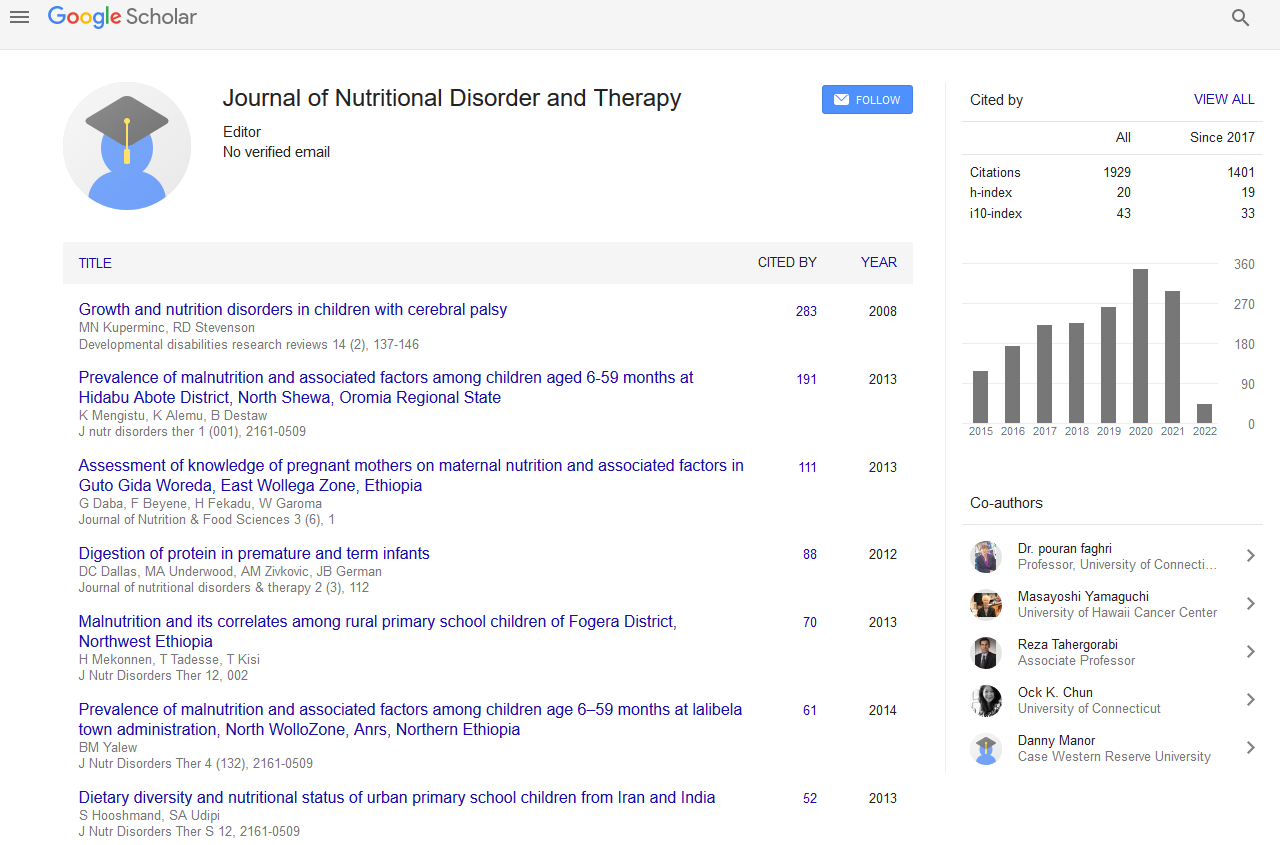Indexed In
- Open J Gate
- Genamics JournalSeek
- Academic Keys
- JournalTOCs
- Ulrich's Periodicals Directory
- RefSeek
- Hamdard University
- EBSCO A-Z
- OCLC- WorldCat
- Publons
- Geneva Foundation for Medical Education and Research
- Euro Pub
Useful Links
Share This Page
Journal Flyer

Open Access Journals
- Agri and Aquaculture
- Biochemistry
- Bioinformatics & Systems Biology
- Business & Management
- Chemistry
- Clinical Sciences
- Engineering
- Food & Nutrition
- General Science
- Genetics & Molecular Biology
- Immunology & Microbiology
- Medical Sciences
- Neuroscience & Psychology
- Nursing & Health Care
- Pharmaceutical Sciences
K36, a synthetic caffeamide derivative, improves the pathology of Alzheimerâ??s disease in high-fat-diet plus streptozotocin-induced hyperinsulinemic and hyperglycemic rats
JOINT EVENT: 13th International Congress on Advances in Natural Medicines Nutraceuticals & Neurocognition & 14th International Conference on Clinical Nutrition
July 27-29, 2017 Rome, Italy
Pei-Chin Wu, Meng-Shiuan Tu, Rong-Shiuan Tu, Shih-Shiang Lin, Yeuh-Hsiung Kuo, Wen-Chang Chang, Yu-Wen Ting, James Swi-Bea Wu and Szu-Chuan Shen
National Taiwan Normal University, Taiwan
China Medical University, Taiwan
National Taiwan University, Taiwan
Posters & Accepted Abstracts: J Nutr Disorders Ther
Abstract:
Type 2 Diabetes Mellitus (T2DM), major caused by obesity and characterized with insulin resistance, is a metabolic disease commonly accompanied with hyperglycemia and hyperinsulinemia. Epidemiology studies have showed that T2DM is a risk factor of Alzheimer�??s disease (AD). Previous studies confirmed that caffeamide improves serum glucose and insulin resistance in diabetic animal model. This study aims to investigate the protective effect of caffeamide derivative compound K36 on pathology of AD in the high-fat-diet (HFD)-streptozotocin (STZ)-induced hyperglycemic and hyperinsulinemic rats. The male Wistar rats were fed with High Fat Diet (60% fat of calorie) for 4 weeks were intra-peritoneally (i.p.) injected with STZ (30 mg/kg b.w.) and then served HFD continuously for 8 weeks to induce hyperglycemia (mean serum glucose 224 mg/ dL) and hyperinsulinemia (mean serum insulin 0.35 ug/ml). The HFD-STZ rats were then orally administered with K36 (15 mg/kg b.w.) once a day for 13 weeks. The Morris Water Maze trial was performed for evaluating the improvement of cognitive impairment before rats were sacrificed. The blood biochemical analysis was conducted after the rats were sacrificed. The expressions of hippocampus and cortex insulin signaling and synaptic function related proteins were analyzed by Western blotting. The rats exhibit hyperglycemia and hyperinsulinemia after HFD and STZ induction. The serum total cholesterol (TG) and serum triglyceride (TC) decreased by 37% and 36%, respectively, in K36 treated HFD-STZ rats compared to the HFD-STZ rats (p<0.05). The results from Morris Water Maze suggested that K36 significantly improved the cognitive ability in HFD-STZ rats (p<0.05). Western blotting assay revealed that the protein expression of cerebral insulin receptor (IR), phosphocAMP response element-binding protein (pCREB), brain-derived neurotrophic factor (BDNF), postsynaptic density protein 95 (PSD-95) in K36 treated HFD-STZ rats were significantly increased compared to the HFD-STZ rats (p<0.05). In addition, K36 also suppressed the expression of brain amyloid precursor protein (APP) in HFD-STZ rats. According to the above results, we suggest that K36 may prevent AD progression via alleviating cerebral insulin resistance and ameliorating synaptic plasticity in HFD-STZ-induced hyperglycemic and hyperinsulinemic rats.


